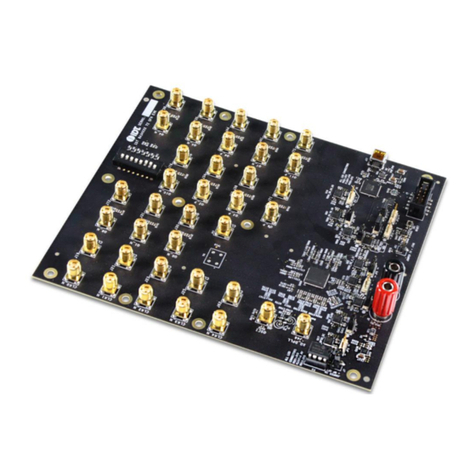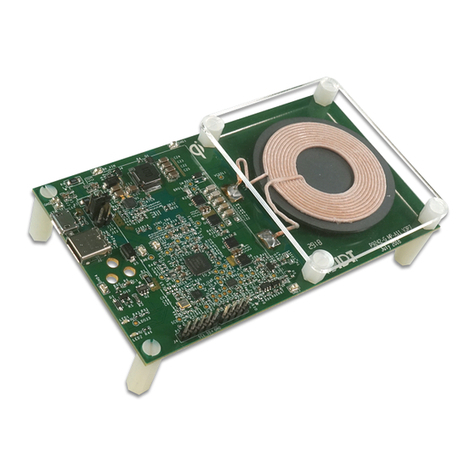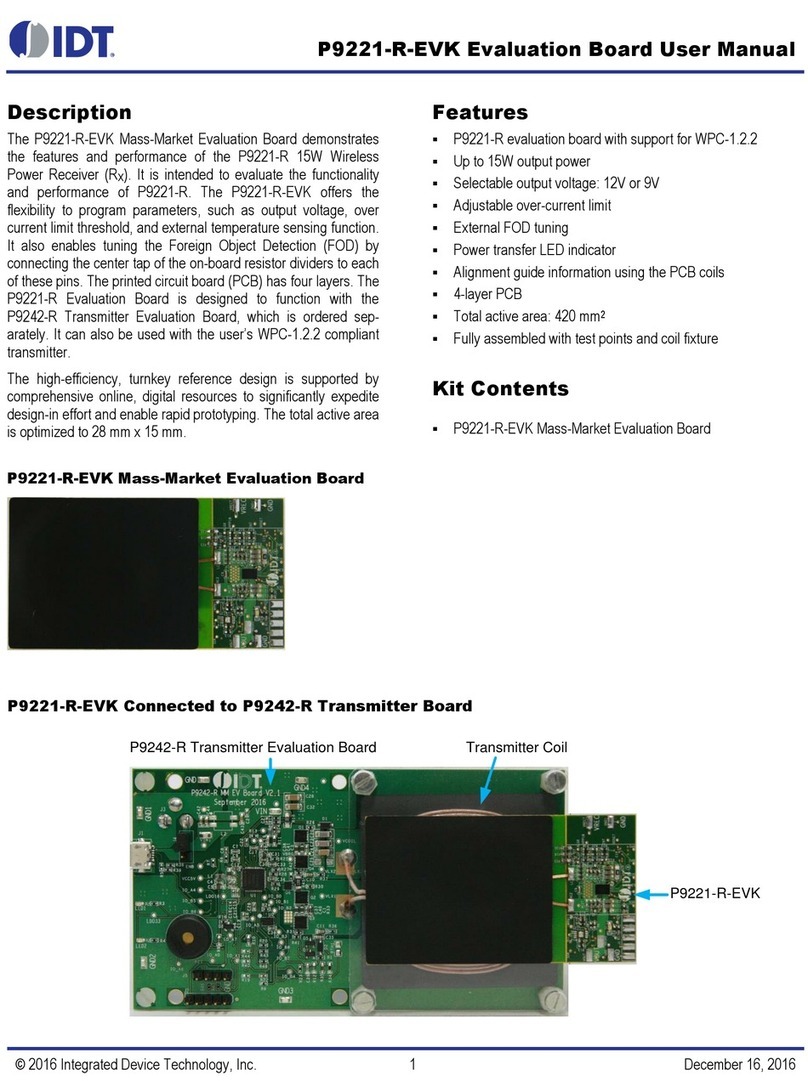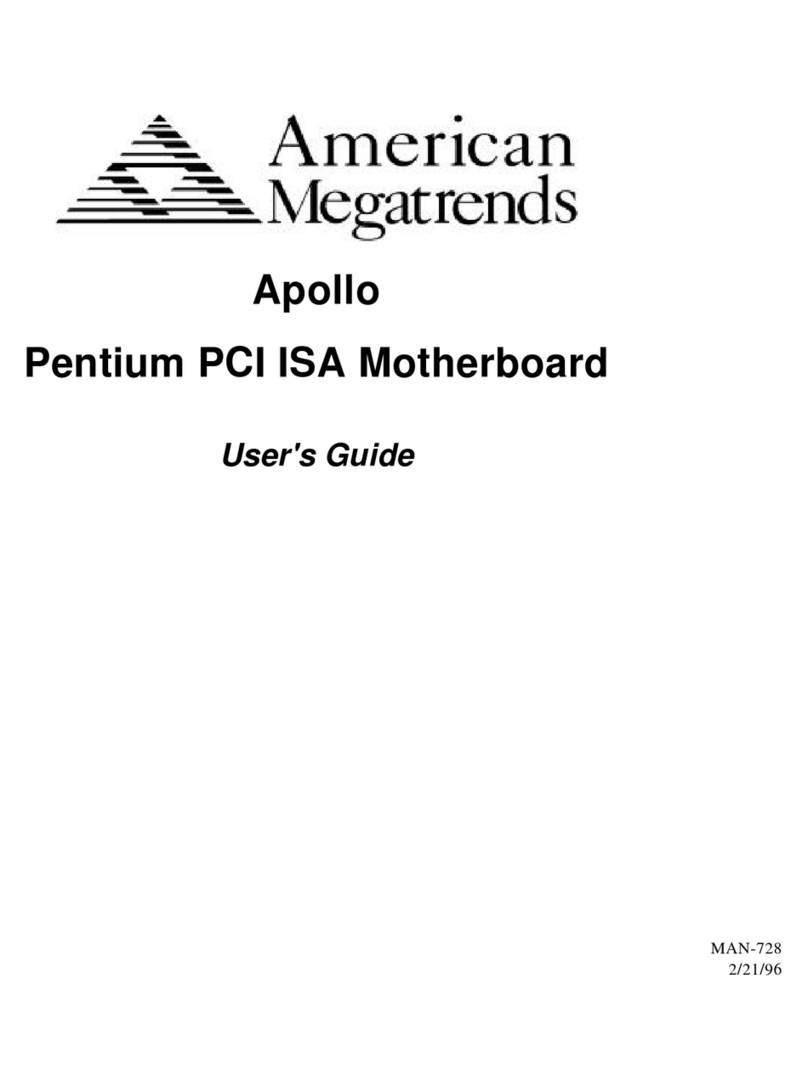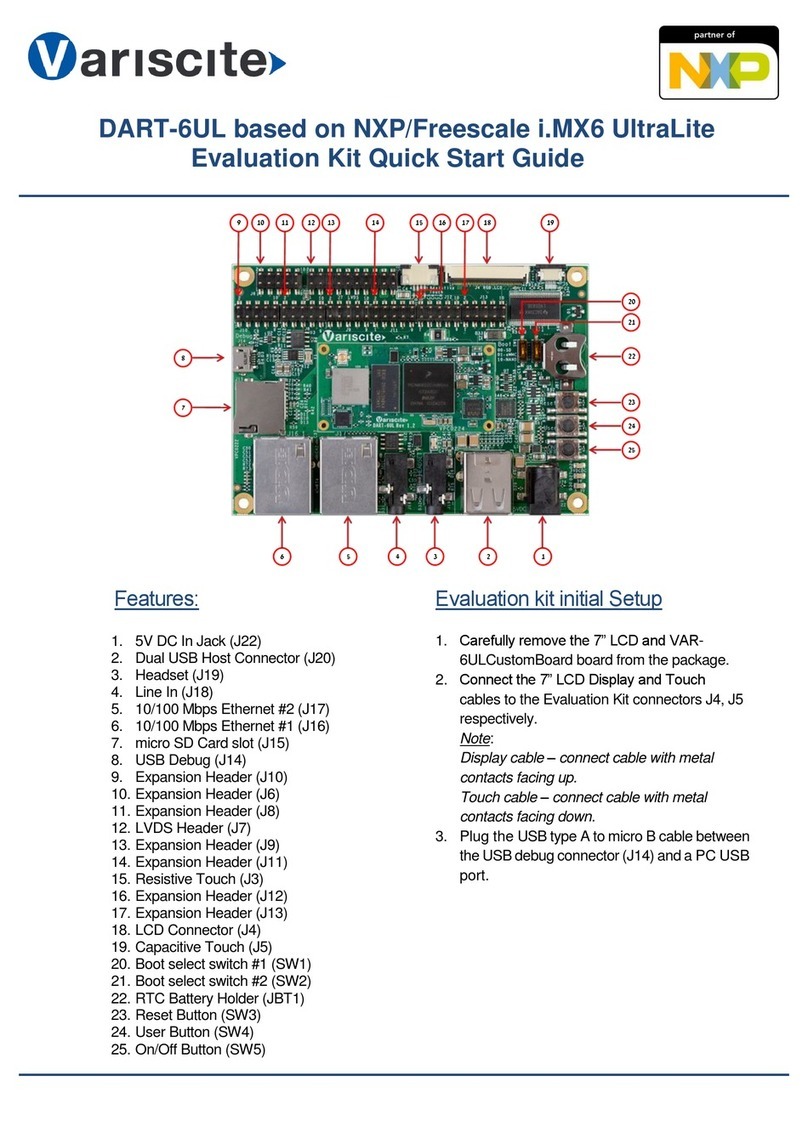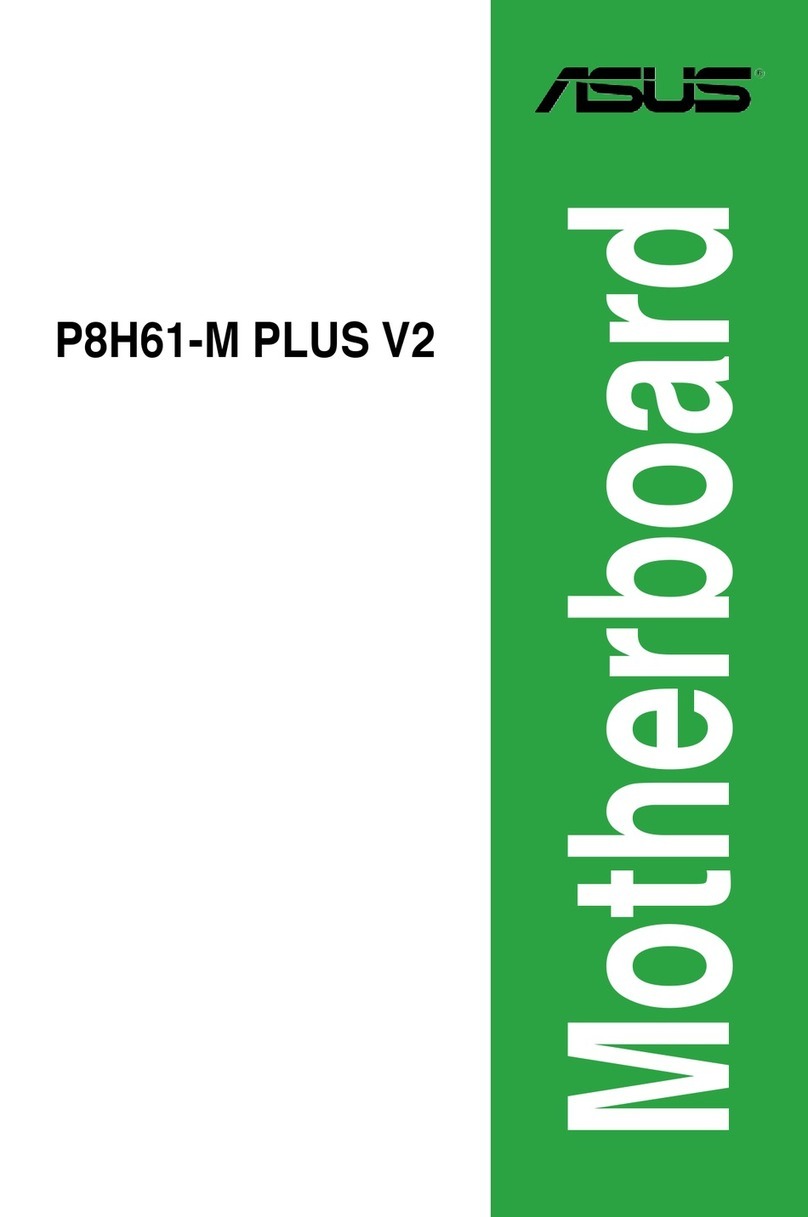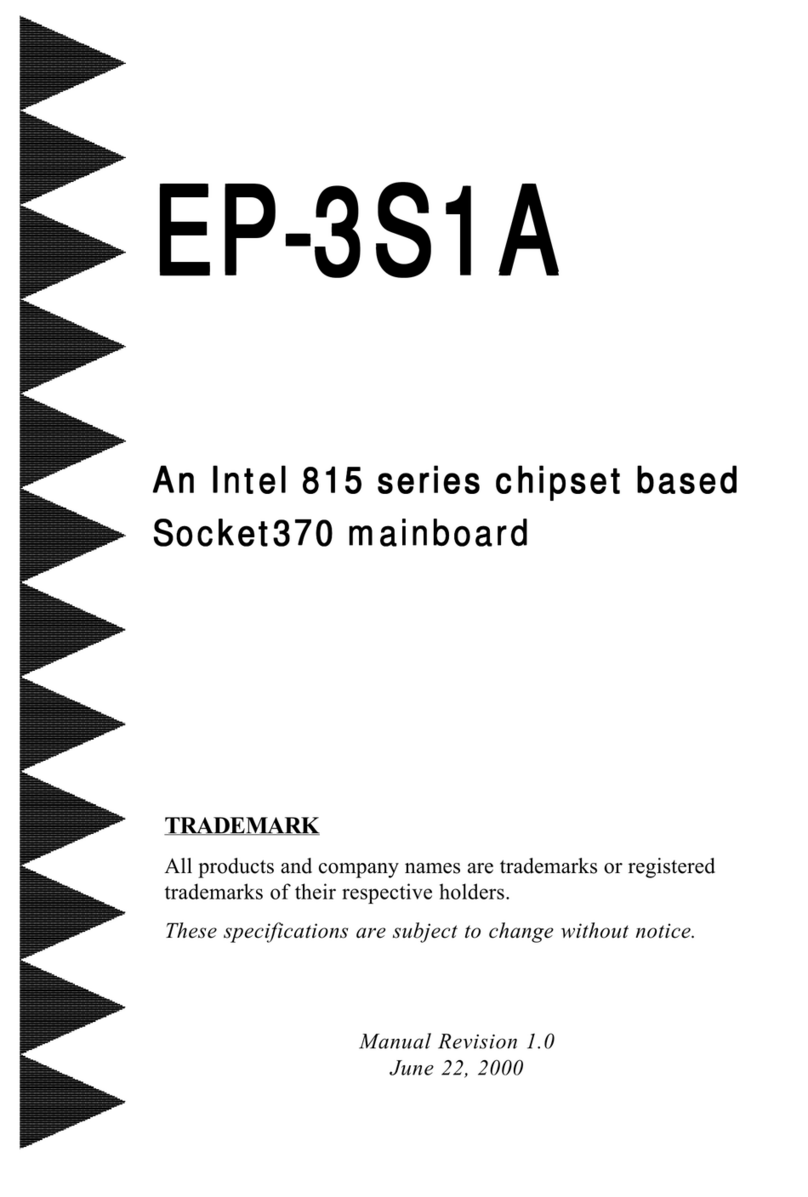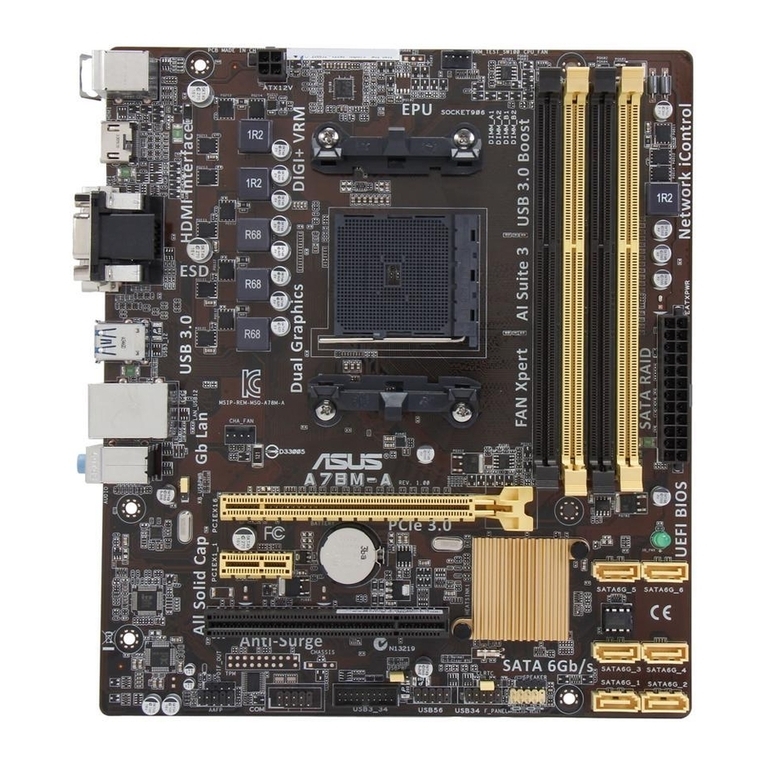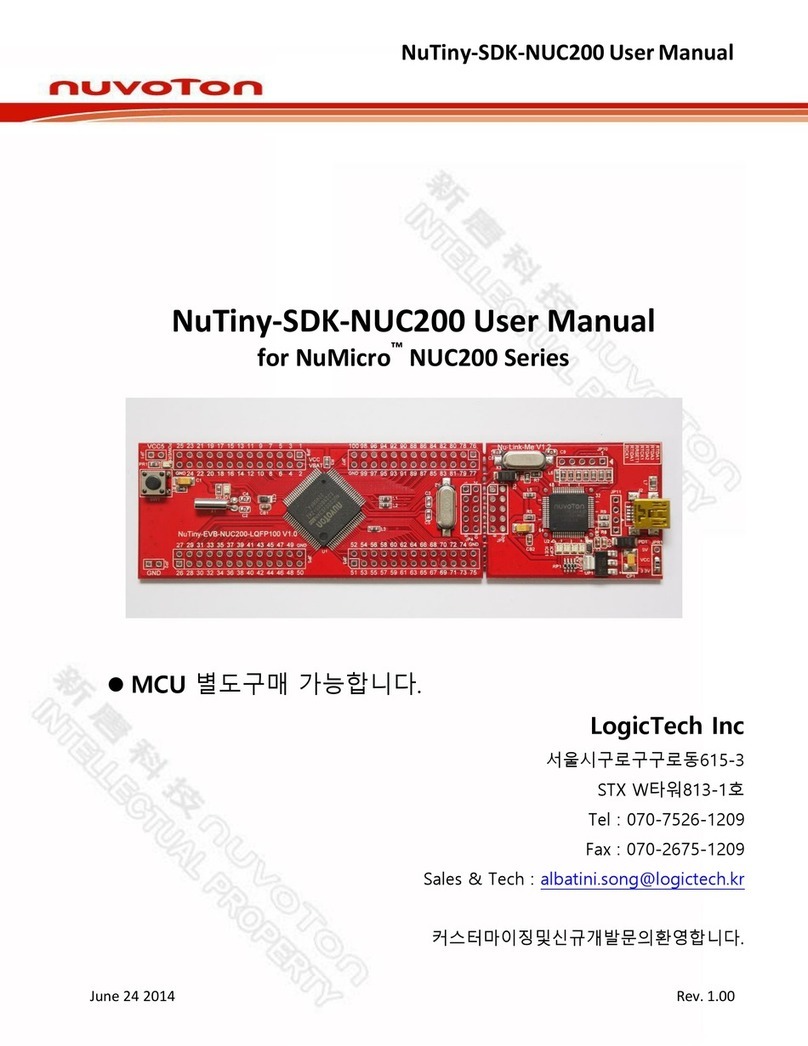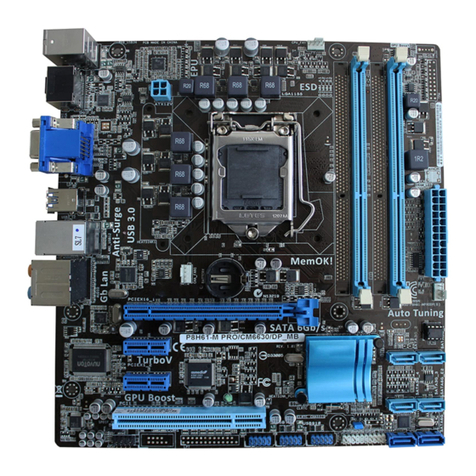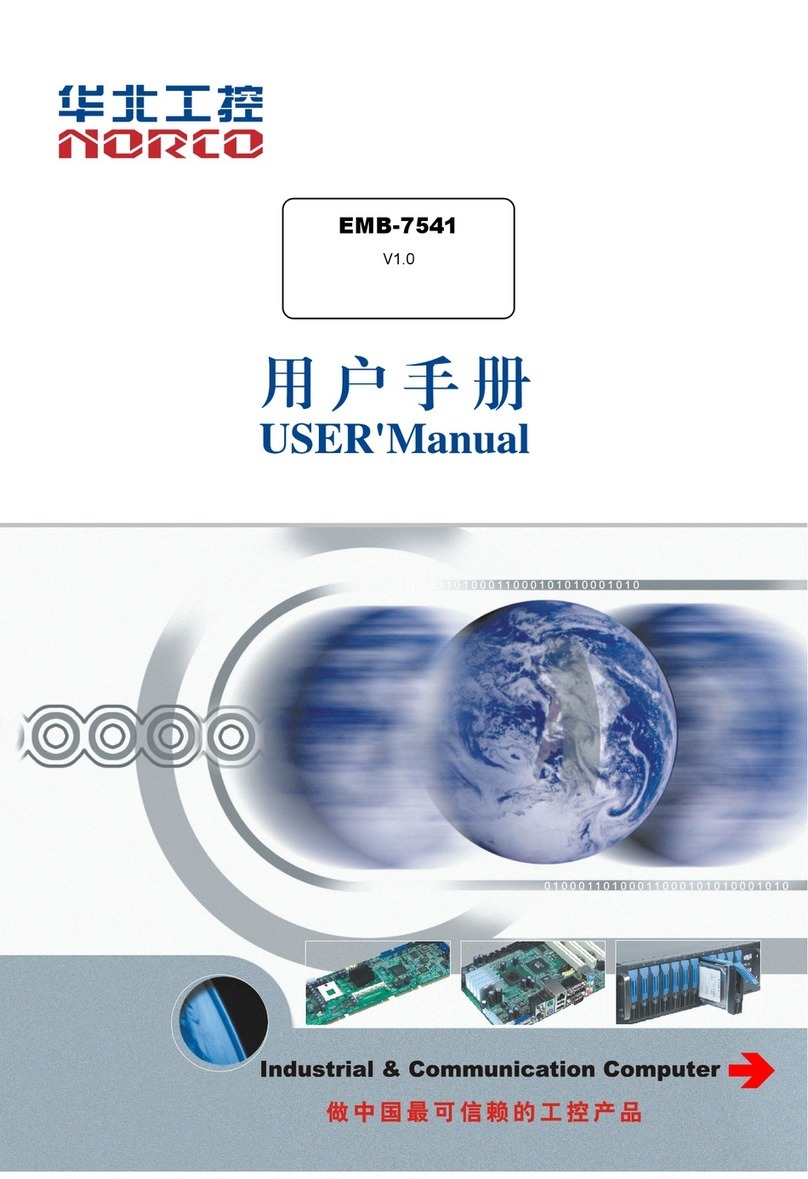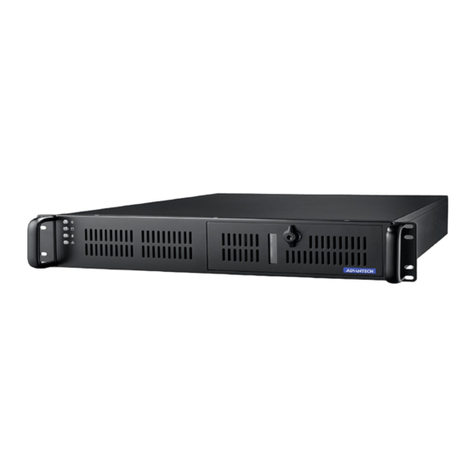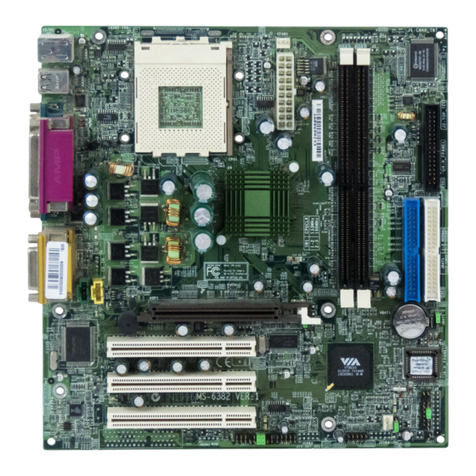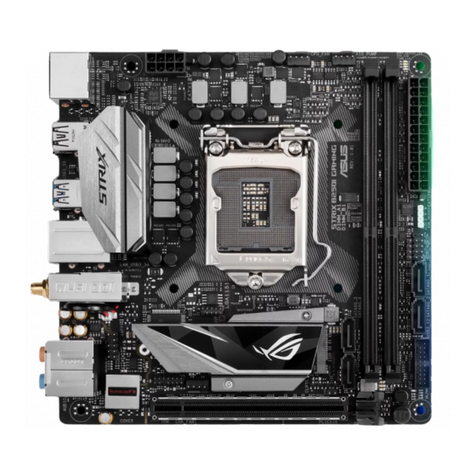IDT Tsi381 User manual

®
6024 Silver Creek Valley Road, San Jose, California 95138
Telephone: (800) 345-7015 • (408) 284-8200 • FAX: (408) 284-2775
Printed in U.S.A.
©2009 Integrated Device Technology, Inc.
Tsi381™
Evaluation Board User Manual
60E2000_MA001_03
September 2009

GENERAL DISCLAIMER
Integrated Device Technology, Inc. reserves the right to make changes to its products or specifications at any time, without notice, in order to improve design or performance
and to supply the best possible product. IDT does not assume any responsibility for use of any circuitry described other than the circuitryembodied in an IDT product. The
Company makes no representations that circuitry described herein is free from patent infringement or other rights of third parties which may result from its use. No license is
granted by implication or otherwise under any patent, patent rights or other rights, of Integrated Device Technology, Inc.
CODE DISCLAIMER
Code examples providedby IDT arefor illustrative purposes only and should notbe relieduponfor developing applications.Any use ofthe code examplesbelow is completely
at your own risk. IDT MAKES NOREPRESENTATIONSOR WARRANTIES OFANY KIND CONCERNING THE NONINFRINGEMENT,QUALITY, SAFETY OR SUITABILITY
OF THE CODE, EITHER EXPRESS OR IMPLIED, INCLUDING WITHOUT LIMITATION ANY IMPLIED WARRANTIES OF MERCHANTABILITY, FITNESS FOR A PARTICU-
LAR PURPOSE, ORNON-INFRINGEMENT. FURTHER,IDT MAKES NO REPRESENTATIONS ORWARRANTIES AS TOTHE TRUTH,ACCURACYOR COMPLETENESS
OF ANY STATEMENTS, INFORMATION OR MATERIALS CONCERNING CODE EXAMPLES CONTAINED IN ANY IDT PUBLICATION OR PUBLIC DISCLOSURE OR
THAT IS CONTAINED ON ANY IDT INTERNET SITE. IN NO EVENT WILL IDT BELIABLE FOR ANY DIRECT, CONSEQUENTIAL, INCIDENTAL, INDIRECT, PUNITIVE OR
SPECIAL DAMAGES, HOWEVER THEY MAY ARISE, AND EVEN IF IDT HAS BEEN PREVIOUSLY ADVISED ABOUT THE POSSIBILITY OF SUCH DAMAGES. The code
examples also may be subject to UnitedStates export control lawsand maybe subject to theexportorimportlawsof other countries andit is your responsibility to comply with
any applicable laws or regulations.
LIFE SUPPORT POLICY
Integrated Device Technology's products are not authorized for use as critical components in lifesupport devices or systemsunless a specific written agreement pertaining to
such intended use is executed between the manufacturer and an officer of IDT.
1. Life support devices or systems are devices or systems which (a) are intended for surgical implant into the body or (b) support or sustain life and whose failure to perform,
when properly used in accordance with instructions for use provided in the labeling, can be reasonably expected to result in a significant injury to the user.
2. A critical component is anycomponents of a life supportdevice or system whosefailure to performcanbe reasonably expected tocause the failure of thelife support device
or system, or to affect its safety or effectiveness.
IDT, the IDT logo, and Integrated Device Technology are trademarks or registered trademarks of Integrated Device Technology, Inc.

Tsi381 Evaluation Board User Manual
60E2000_MA001_03
Integrated Device Technology
www.idt.com
3
Contents
About this Document. . . . . . . . . . . . . . . . . . . . . . . . . . . . . . . . . . . . . . . . . . . . . . . . . . . . . 5
Related Information . . . . . . . . . . . . . . . . . . . . . . . . . . . . . . . . . . . . . . . . . . . . . . . . . . . . . . . . . . . . . . . . . . . . . . . . . . . . . . 5
Acronyms . . . . . . . . . . . . . . . . . . . . . . . . . . . . . . . . . . . . . . . . . . . . . . . . . . . . . . . . . . . . . . . . . . . . . . . . . . . . . . . . . . . . . . 5
Revision History . . . . . . . . . . . . . . . . . . . . . . . . . . . . . . . . . . . . . . . . . . . . . . . . . . . . . . . . . . . . . . . . . . . . . . . . . . . . . . . . . 5
1. Board Design . . . . . . . . . . . . . . . . . . . . . . . . . . . . . . . . . . . . . . . . . . . . . . . . . . . . . . . 7
1.1 Overview . . . . . . . . . . . . . . . . . . . . . . . . . . . . . . . . . . . . . . . . . . . . . . . . . . . . . . . . . . . . . . . . . . . . . . . . . . . . . . . . . 7
1.2 PCI Interface . . . . . . . . . . . . . . . . . . . . . . . . . . . . . . . . . . . . . . . . . . . . . . . . . . . . . . . . . . . . . . . . . . . . . . . . . . . . . . 9
1.2.1 Overview . . . . . . . . . . . . . . . . . . . . . . . . . . . . . . . . . . . . . . . . . . . . . . . . . . . . . . . . . . . . . . . . . . . . . . . . . 9
1.2.2 IDSEL Signals . . . . . . . . . . . . . . . . . . . . . . . . . . . . . . . . . . . . . . . . . . . . . . . . . . . . . . . . . . . . . . . . . . . . . 9
1.2.3 Interrupt Signals. . . . . . . . . . . . . . . . . . . . . . . . . . . . . . . . . . . . . . . . . . . . . . . . . . . . . . . . . . . . . . . . . . . . 9
1.2.4 Pull-up Signals. . . . . . . . . . . . . . . . . . . . . . . . . . . . . . . . . . . . . . . . . . . . . . . . . . . . . . . . . . . . . . . . . . . . . 9
1.3 PCIe Interface. . . . . . . . . . . . . . . . . . . . . . . . . . . . . . . . . . . . . . . . . . . . . . . . . . . . . . . . . . . . . . . . . . . . . . . . . . . . . 10
1.4 Power Management . . . . . . . . . . . . . . . . . . . . . . . . . . . . . . . . . . . . . . . . . . . . . . . . . . . . . . . . . . . . . . . . . . . . . . . . 10
1.4.1 Power Regulation. . . . . . . . . . . . . . . . . . . . . . . . . . . . . . . . . . . . . . . . . . . . . . . . . . . . . . . . . . . . . . . . . . 10
1.4.2 Power Requirements . . . . . . . . . . . . . . . . . . . . . . . . . . . . . . . . . . . . . . . . . . . . . . . . . . . . . . . . . . . . . . . 11
1.4.3 Power Sequencing . . . . . . . . . . . . . . . . . . . . . . . . . . . . . . . . . . . . . . . . . . . . . . . . . . . . . . . . . . . . . . . . . 13
1.4.4 System Power Design . . . . . . . . . . . . . . . . . . . . . . . . . . . . . . . . . . . . . . . . . . . . . . . . . . . . . . . . . . . . . . 13
1.4.5 PCI Vaux (PCI Auxiliary) Support . . . . . . . . . . . . . . . . . . . . . . . . . . . . . . . . . . . . . . . . . . . . . . . . . . . . 14
1.5 Clock Management . . . . . . . . . . . . . . . . . . . . . . . . . . . . . . . . . . . . . . . . . . . . . . . . . . . . . . . . . . . . . . . . . . . . . . . . 14
1.5.1 PCI . . . . . . . . . . . . . . . . . . . . . . . . . . . . . . . . . . . . . . . . . . . . . . . . . . . . . . . . . . . . . . . . . . . . . . . . . . . . . 14
1.5.2 System Clock Distribution. . . . . . . . . . . . . . . . . . . . . . . . . . . . . . . . . . . . . . . . . . . . . . . . . . . . . . . . . . . 15
1.6 Other Interfaces . . . . . . . . . . . . . . . . . . . . . . . . . . . . . . . . . . . . . . . . . . . . . . . . . . . . . . . . . . . . . . . . . . . . . . . . . . . 15
1.6.1 JTAG Interface. . . . . . . . . . . . . . . . . . . . . . . . . . . . . . . . . . . . . . . . . . . . . . . . . . . . . . . . . . . . . . . . . . . . 15
1.6.2 EEPROM Interface . . . . . . . . . . . . . . . . . . . . . . . . . . . . . . . . . . . . . . . . . . . . . . . . . . . . . . . . . . . . . . . . 15
1.6.3 GPIO Interface. . . . . . . . . . . . . . . . . . . . . . . . . . . . . . . . . . . . . . . . . . . . . . . . . . . . . . . . . . . . . . . . . . . . 16
1.7 Hardware Reset . . . . . . . . . . . . . . . . . . . . . . . . . . . . . . . . . . . . . . . . . . . . . . . . . . . . . . . . . . . . . . . . . . . . . . . . . . . 16
1.8 Logic Analyzer Connectivity. . . . . . . . . . . . . . . . . . . . . . . . . . . . . . . . . . . . . . . . . . . . . . . . . . . . . . . . . . . . . . . . . 17
2. Configurable Options. . . . . . . . . . . . . . . . . . . . . . . . . . . . . . . . . . . . . . . . . . . . . . . . 19
2.1 Switches . . . . . . . . . . . . . . . . . . . . . . . . . . . . . . . . . . . . . . . . . . . . . . . . . . . . . . . . . . . . . . . . . . . . . . . . . . . . . . . . . 19
2.1.1 DIP Switches . . . . . . . . . . . . . . . . . . . . . . . . . . . . . . . . . . . . . . . . . . . . . . . . . . . . . . . . . . . . . . . . . . . . . 19
2.1.2 Push Button . . . . . . . . . . . . . . . . . . . . . . . . . . . . . . . . . . . . . . . . . . . . . . . . . . . . . . . . . . . . . . . . . . . . . . 23
2.2 Shunt Jumpers . . . . . . . . . . . . . . . . . . . . . . . . . . . . . . . . . . . . . . . . . . . . . . . . . . . . . . . . . . . . . . . . . . . . . . . . . . . . 24
2.2.1 J6 Shunt Jumper. . . . . . . . . . . . . . . . . . . . . . . . . . . . . . . . . . . . . . . . . . . . . . . . . . . . . . . . . . . . . . . . . . . 25
2.2.2 J21 Shunt Jumper. . . . . . . . . . . . . . . . . . . . . . . . . . . . . . . . . . . . . . . . . . . . . . . . . . . . . . . . . . . . . . . . . . 25
2.3 Debug Headers. . . . . . . . . . . . . . . . . . . . . . . . . . . . . . . . . . . . . . . . . . . . . . . . . . . . . . . . . . . . . . . . . . . . . . . . . . . . 26
2.3.1 J22 Tsi381 JTAG . . . . . . . . . . . . . . . . . . . . . . . . . . . . . . . . . . . . . . . . . . . . . . . . . . . . . . . . . . . . . . . . . . 27
2.3.2 J23 Logic Analyzer PADs . . . . . . . . . . . . . . . . . . . . . . . . . . . . . . . . . . . . . . . . . . . . . . . . . . . . . . . . . . . 28
2.4 Connectors . . . . . . . . . . . . . . . . . . . . . . . . . . . . . . . . . . . . . . . . . . . . . . . . . . . . . . . . . . . . . . . . . . . . . . . . . . . . . . . 29
2.4.1 J1, J2, J36, J37 Connectors . . . . . . . . . . . . . . . . . . . . . . . . . . . . . . . . . . . . . . . . . . . . . . . . . . . . . . . . . . 30
2.4.2 J3 ATX Power Connector. . . . . . . . . . . . . . . . . . . . . . . . . . . . . . . . . . . . . . . . . . . . . . . . . . . . . . . . . . . . 30

Contents4
Tsi381 Evaluation Board User Manual
60E2000_MA001_03 Integrated Device Technology
www.idt.com
2.4.3 P1 x1 PCIe Finger Connector . . . . . . . . . . . . . . . . . . . . . . . . . . . . . . . . . . . . . . . . . . . . . . . . . . . . . . . . 31
2.5 LEDs . . . . . . . . . . . . . . . . . . . . . . . . . . . . . . . . . . . . . . . . . . . . . . . . . . . . . . . . . . . . . . . . . . . . . . . . . . . . . . . . . . . 31
3. Bill of Materials . . . . . . . . . . . . . . . . . . . . . . . . . . . . . . . . . . . . . . . . . . . . . . . . . . . . .33

5
Tsi381 Evaluation Board User Manual
60E2000_MA001_03
Integrated Device Technology
www.idt.com
About this Document
This document describes how to test the key features of the Tsi381 using the Tsi381 evaluation board.
It can be used in conjunction with the Tsi381 Evaluation Board Schematics.
Related Information
• Tsi381 User Manual
• Tsi381 Evaluation Board Schematics
• Tsi381 Board Design Guidelines
•PCI Express Base Specification (Revision 1.1)
• PCI Express CEM Specification (Revision 1.1)
•PCI Express-to-PCI/PCI-X Bridge Specification (Revision 1.0)
Acronyms
Revision History
60E2000_MA001_03, Formal, September 2009
This document was rebranded as IDT. It does not include any technical changes.
60E2000_MA001_02, Formal, September 2007
Added a new section that discusses “PCI Vaux (PCI Auxiliary) Support”.
60E2000_MA001_01, Formal, August 2007
This is the first version of the Tsi382 PCIe-to-PCI Bridge User Manual.
Term Definition
PCIe PCI Express
SerDes Serial/De-serializer

About this Document6
Tsi381 Evaluation Board User Manual
60E2000_MA001_03 Integrated Device Technology
www.idt.com

7
Tsi381 Evaluation Board User Manual
60E2000_MA001_03
Integrated Device Technology
www.idt.com
1. Board Design
Topics discussed include the following:
•“Overview” on page 7
•“PCI Interface” on page 9
•“PCIe Interface” on page 10
•“Power Management” on page 10
•“Clock Management” on page 14
•“Other Interfaces” on page 15
•“Hardware Reset” on page 16
•“Logic Analyzer Connectivity” on page 17
1.1 Overview
The key features of the Tsi381 evaluation board include the following (see also Figure 1):
• Single x1 lane, 2.5 Gbps PCIe 1.1 compatible riser card (extended height form factor)
• Four PCI slots
• 32-bit PCI bus, 25–66 MHz operation
• PCI power support through system or external supply
• PCIe compliance/debugging test points

1. Board Design8
Tsi381 Evaluation Board User Manual
60E2000_MA001_03 Integrated Device Technology
www.idt.com
Figure 1: Evaluation Board Block Diagram
EEPROM
Tsi381
3.3V PCI 32-bit Connector
Slot 0
PCI
Power
Management
PCI Express Card Edge X1
PCIe
LA Probe
JTAG
Header
ATX Connectors
EEPROM
1x SerDes SMA
Points
SerDes Path
Resistor Select
Clock
Management
3.3V PCI 32-bit Connector
Slot 1
3.3V PCI 32-bit Connector
Slot 2
3.3V PCI 32-bit Connector
Slot 3
GPIO
GPIO

1. Board Design 9
Tsi381 Evaluation Board User Manual
60E2000_MA001_03
Integrated Device Technology
www.idt.com
1.2 PCI Interface
1.2.1 Overview
The PCI Interface is implemented on the board with four slots, in which one is an R/A mounted
connector on the top of the board. All PCI connectors are compliant with the PCI 3.0 specification.
Appropriate clearance is provided such that up to four PCI cards can be inserted for testing while the
board is in an open-chassis standard ATX case.
The PCI Interface supports four slots operating at 25, 33, 50, or 66 MHz.
1.2.2 IDSEL Signals
IDSEL signals are connected in the following order:
• Slot 0 – R/A connector top slot: 150 ohms to AD16 (Device 0)
• Slot 1 – 150 ohms to AD17 (Device 1)
• Slot 2 – 150 ohms to AD19 (Device 3)
• Slot 3 – 150 ohms AD18 (Device 2)
1.2.3 Interrupt Signals
The PCI interrupt signals are connected to the slots as shown in the following table.
1.2.4 Pull-up Signals
The following pull-ups are added to the PCI bus, in which a value of 8.2Kohm is used.
Table 1: PCI Interrupt Routing
Tsi381 Slot 0 Slot 1 Slot 3 Slot 4
AABDC
BBCAD
CCDBA
DDACB
Table 2: PCI Pull-up Signals
Signal Description
PCI_REQ#[0:3] Bus request
PCI_GNT#[0:3] Bus grant
PCI_FRAME# Control signal
PCI_IRDY#, PCI_TRDY# Control signal

1. Board Design10
Tsi381 Evaluation Board User Manual
60E2000_MA001_03 Integrated Device Technology
www.idt.com
1.3 PCIe Interface
The Tsi381 evaluation board implements a single lane PCIe Interface. It is designed to connect to a
PCIe system with a standard x1 finger connector. The system must provide the REFCLK and PERSTN
signals. The PCIe Interface has the following design elements:
• Supports Hot insertion and removal
• Mid-bus logic analyzer pads for PCIe RXD/TXD signal probing
• AC coupling on the TXD lanes
• JTAG TDI - TDO loopback for chain continuity
1.4 Power Management
1.4.1 Power Regulation
The evaluation board’s power regulation is implemented as follows:
• Digital 3.3V power supply available from DC/DC regulator or ATX supply
• Digital 1.2V switching regulator
• PCIe supplies filtered using EMI ferrite networks
To support PCI cards, the following additional power resources are included:
• 12V to 5V DC/DC converter
• 12V to 3.3V DC/DC converter
• External power connectors – ATX 20-pin connector for supplying all power from an ATX power
supply
PCI_STOP# Control signal
PCI_SERR# System error
PCI_PERR# Parity error
PCI_DEVSEL# Device select line
PCI_INT#[A:D] Interrupt line
PCI_PME# PCI Power Management Event occurred
Table 2: PCI Pull-up Signals (Continued)
Signal Description

1. Board Design 11
Tsi381 Evaluation Board User Manual
60E2000_MA001_03
Integrated Device Technology
www.idt.com
1.4.2 Power Requirements
The power requirements and implementation for the Tsi381 is as follows.
The target power draw of the Tsi381 is a maximum of 1W, all supplies combined. The supplies to the
Tsi381 are controlled during ramp up using enable pins on regulators and switches.
1.4.2.1 PCIe
The PCIe CEM Specification 1.1 defines power limits on PCIe slots according to the number of lanes
available on a card. Power rules regarding x1 PCIe slots are a maximum of 25W slot. Current limits are
included in Table 4.
The usage of the 12V supply provides access to the full 25W available from the system to the board.
The PCIe pinout design includes more 12V power pins as it allows more power-per-pin capability. The
evaluation board regulates all power from the 12V system rail; however, 3.3V from the system remains
unused.
Table 3: Tsi381 Power Requirements
Supply Name Symbol Supplied Source
Device Core 1.2V_384 DC/DC switching regulator w/Enable pin
PCIe 1.2V Core 1.2V_A_384 Passive Filter
PCI 3.3V supply 3.3V_384 Power switch w optional Ferrite filter to reduce
EMI/noise from PCI environment
PCIe 3.3V supply 3.3V_A_384 Passive Filter
Table 4: PCIe Connector Current Limits
Rail Current
3.3V 3A
12V 2.1A

1. Board Design12
Tsi381 Evaluation Board User Manual
60E2000_MA001_03 Integrated Device Technology
www.idt.com
1.4.2.2 PCI
The PCISIG defines the power rules regarding PCI cards as a maximum of 25 Watts per card (All
power rails combined power draw). The individual current limits on voltage rails are included in
Table 5.
It is not possible to provide the full power required to the PCI bus without violating the specification
while drawing power from only a x1 PCIe system. Up to 23W not including regulator efficiency losses
can be made available. The evaluation board provides the power requirements in one of two ways
depending on the application:
• PCIe system power
• ATX System connector
The following conditions summarize the power available for a single PCI card without external supply.
An efficiency of 85% is taken into account for switching regulators. These limits can be exceeded in
cases where the system can provide more than the suggested limit, which is usually only implemented
in hot swap systems.
For additional slots, or in cases where the system cannot supply enough power, a separate ATX power
connector is used to power the card. The evaluation board senses the presence of this supply, and
disables the slave PCIe slot power. For the case of a separate external ATX supply, all four slots are
provided with the required power.
Table 5: PCI Connector Current Limits
Rail Current
3.3V 7.6a
5V 5a
-12V 100ma
12V 500ma
Table 6: PCI Connector Current Limit with No External Supply
Rail Supplying Topology Current (Maximum)
3.3V 12V to 3.3V regulator 6A
12V 12V directly 500mA
-12V N/A N/A
5V 12V to 5V regulator 4A

1. Board Design 13
Tsi381 Evaluation Board User Manual
60E2000_MA001_03
Integrated Device Technology
www.idt.com
1.4.3 Power Sequencing
On power-up, the board’s power sequence is as follows:
1. 1.2V powered on
2. PCI I/O slot power and pull-ups, and Tsi381 3.3V
12V/-12V/5V PCI are not sequence controlled.
1.4.4 System Power Design
Figure 2 illustrates the power distribution for the riser card. The following list is a functional summary
of the power design:
1. Sequencing control over the following rails:
•3.3VPCI
• 3.3V Tsi381 I/O/PCIe AVDD
• 1.2V Tsi381 Core/PCIe VDD
2. ATX 20-pin connector override, which disables all power draw from the PCIe system.
Figure 2: System Power Distribution
3v3/5v DC/DC
Regulator
(TPS5124)
PCIe
System
12v
ATX
20-pin
-12v
12v
5v
3.3v
Unused
GND
1.2v DC/DC
12V
3.3V
1.2V
Power
Sequencer
3.3v/5v Disable
1.2V PCIE_VDD
3.3V PCIE AVDD
-12V
3.3V I/O
PCI
Bus
Connectors
Current
Sense
Current
Sense
Current
Sense
Current
Sense
Tsi381
Electronic/Mech
Breaker w/
Current Limit

1. Board Design14
Tsi381 Evaluation Board User Manual
60E2000_MA001_03 Integrated Device Technology
www.idt.com
1.4.5 PCI Vaux (PCI Auxiliary) Support
PCI connectors are provided with a 3.3V supply to the vaux pins only during operation. There is no
support for this power supply in standby mode. This feature is not documented in the Tsi381 evaluation
board schematic.
1.5 Clock Management
The Tsi381 requires up to two input clocks to operate:
• 25–66 MHz clock for PCI
• 100-MHz reference clock for PCIe
The PCI and PCIe input clocks are briefly discussed.
1.5.1 PCI
The evaluation board supports master and slave clocking for PCI.
• Master – When in master mode, the Tsi381 generates the required PCI clock for all slots.
• Slave – When in slave mode, an on-board selectable 25–66 MHz clock generator is used.
On-board resistor muxes are used to multiplex either Tsi381’s PCI clock or the external clock
generator.
1.5.1.1 PCIe
For PCIe clocking, a 100-MHz differential HCSL clock source is required. The clock source is
available in two forms:
• Edge connector clock source – This clock source synchronizes the system SerDes with the Tsi381.
• On-board 100-MHz reference – This clock source can separate the clock domains between the
bridge and the root complex.
The two PCIe clock sources are multiplexed with an analog multiplexer to select between the system
clock or on-board clock (see Figure 3).

1. Board Design 15
Tsi381 Evaluation Board User Manual
60E2000_MA001_03
Integrated Device Technology
www.idt.com
1.5.2 System Clock Distribution
The following figure shows the distribution of the system clock on the Tsi381 evaluation board.
Figure 3: System Clock Distribution
1.6 Other Interfaces
1.6.1 JTAG Interface
To support debug and testing of device, JTAG access to the Tsi381 is available using a standard JTAG
header for Wiggler connection.
1.6.2 EEPROM Interface
A single EEPROM device socket is available for programming the Tsi381’s registers during startup.
The socket is in an 8-pin DIP format.
Tip
For more information about accessing the Tsi381 using JTAG, see the JTAG Register Access
Software Application Note.
ICS87604I
PCIe System
PCIe_REFCLK
PCI Bus
Connectors
Tsi381
PCI_CLK
CLKOUT[0:1] PCI_INT_CLK[0]
PCI_EXT_CLK[0]
PCI Clock
Buffer
CY2305
PCI_FBK_CLK
PCI_CLK[0:3]
PLD
ICS557-01
Diff.
SMA
Input
Passive
Mux
(0r0 RES)
ANALOG
MUX
PCIe_SYS_CLK
PCIe_GEN_CLK
PCIe_BERT_CLK
PCIe_REF_CLK
(AC coupled)
Config PCI_EXT_CLK[1]
Resistor Mux
for CPLD
PCI_INT_CLK[1]

1. Board Design16
Tsi381 Evaluation Board User Manual
60E2000_MA001_03 Integrated Device Technology
www.idt.com
1.6.3 GPIO Interface
The GPIO Interface is comprised of the following:
• On-board LEDs on GPIO lines
• Available 100mil Header to send/receive external 3.3V level signals
The following list outlines the connections to GPIO:
• External I/O header:
— J7.1: NC
— J7.2: GPIO0
— J7.3: GPIO1
— J7.4: GPIO2
— J7.5: GPIO3
— J7.6: Connected to ground
• LEDs:
— D11: GPIO0, active led when driven low
— D1: GPIO1, active led when driven low
— D13: GPIO2, active led when driven low
— D12: GPIO3, active led when driven low
1.7 Hardware Reset
The following figure shows the reset options of the Tsi381 evaluation board.
Figure 4: Board Reset
PCIe Edge Connector X1
Reset
Controller
SYS_PCIe_PERSTn
PUSHBUTTON PCIe_PERSTn

1. Board Design 17
Tsi381 Evaluation Board User Manual
60E2000_MA001_03
Integrated Device Technology
www.idt.com
Three levels of reset are available:
• Cold reset – This reset is applied during power up. System (card edge) PCIe_PERSTn is muxed
with the board’s reset controller.
• Warm reset – This reset is activated by a push-button reset on the board.
• Hot reset – This reset is activated by the in-band message sent by the root complex. No supporting
hardware is necessary.
1.8 Logic Analyzer Connectivity
The serial buses have Midbus pads (TMS818 probe) for visibility of SerDes lines using a
pre-processor. Each probing pad provides access to the RX and TX segments of a x1 link.
To access the PCI bus, a Nexus PCI interposer card can be used with Tektronix mictor cables. The card
can be plugged into any PCI edge slot, or in-line with the device under test.
Tip
For more information on cold, warm, and hot reset levels, see the “Resets, Clocking, and
Initialization Options” chapter in the Tsi381 User Manual.

1. Board Design18
Tsi381 Evaluation Board User Manual
60E2000_MA001_03 Integrated Device Technology
www.idt.com

19
Tsi381 Evaluation Board User Manual
60E2000_MA001_03
Integrated Device Technology
www.idt.com
2. Configurable Options
Topics discussed include the following:
•“Switches” on page 19
•“Shunt Jumpers” on page 24
•“Debug Headers” on page 26
•“Connectors” on page 29
•“LEDs” on page 31
2.1 Switches
2.1.1 DIP Switches
Switches S1 to S6 combine four, small slide switches identified with numbers 1 to 4 (see Table 7 for
individual switch definition).
Figure 5: DIP Switch Package/Individual Switch Position
ON
OFF

2. Configurable Options20
Tsi381 Evaluation Board User Manual
60E2000_MA001_03 Integrated Device Technology
www.idt.com
Figure 6: Switch Locations
SW2
S3
S4
SW1
S5
S6
S1
This manual suits for next models
2
Table of contents
Other IDT Motherboard manuals
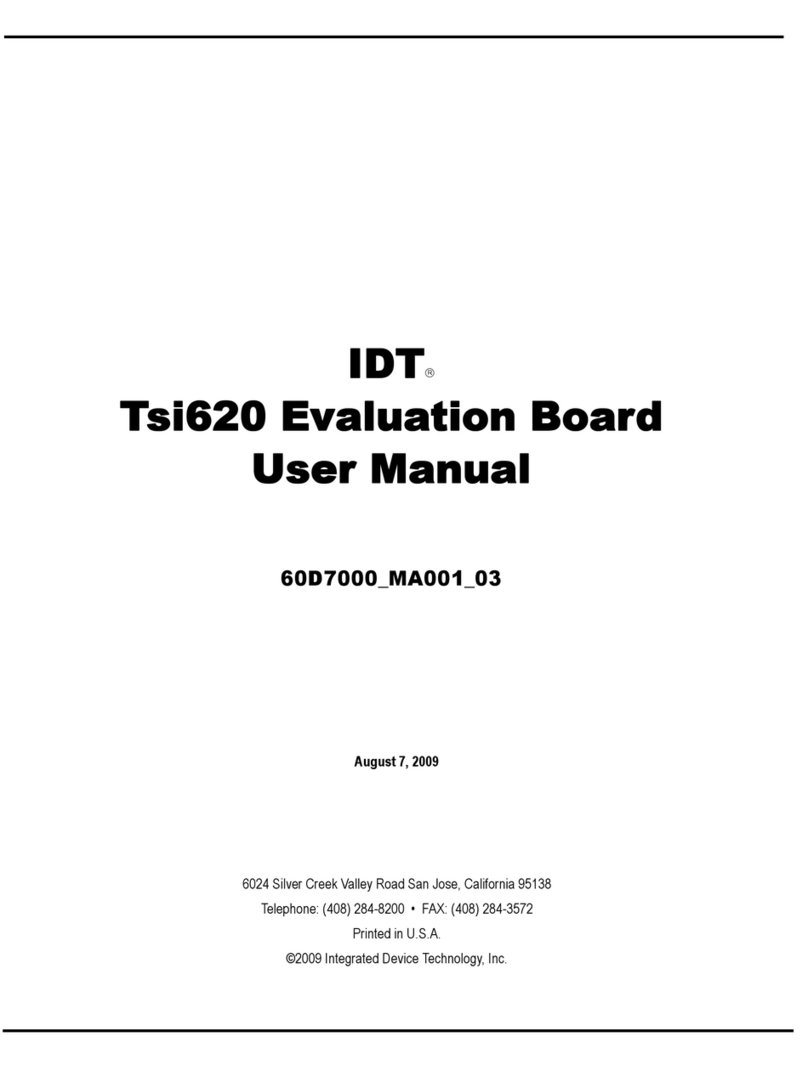
IDT
IDT Tsi620 User manual
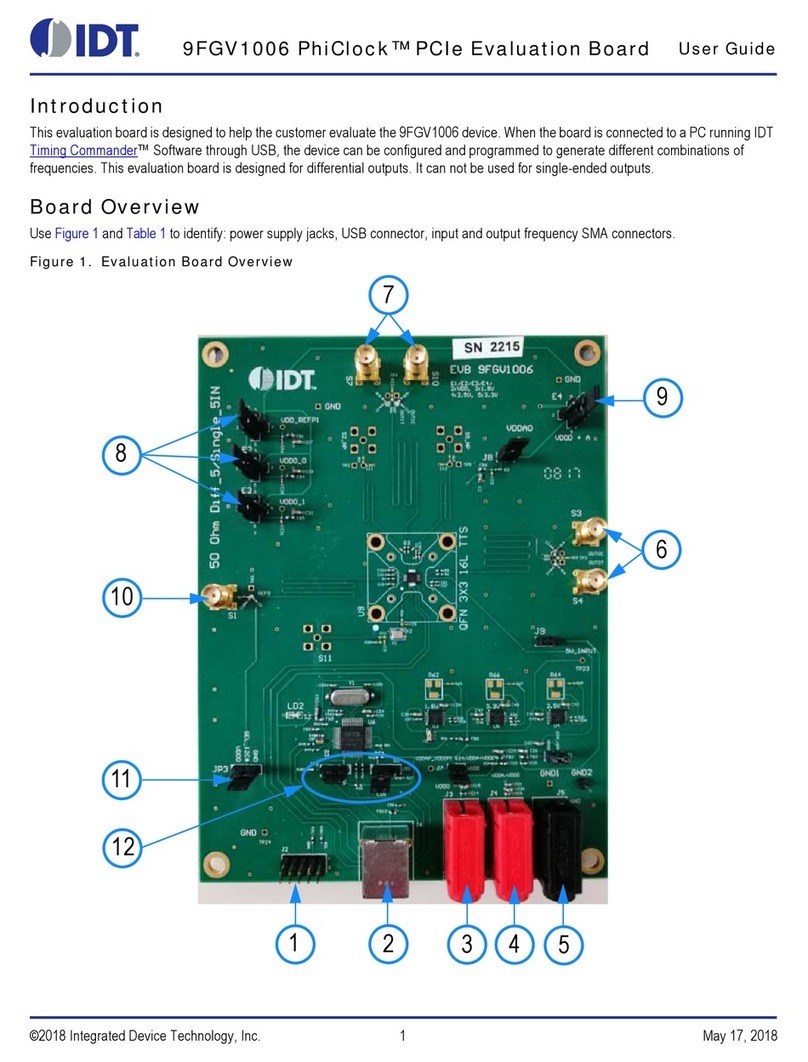
IDT
IDT 9FGV1006 User manual
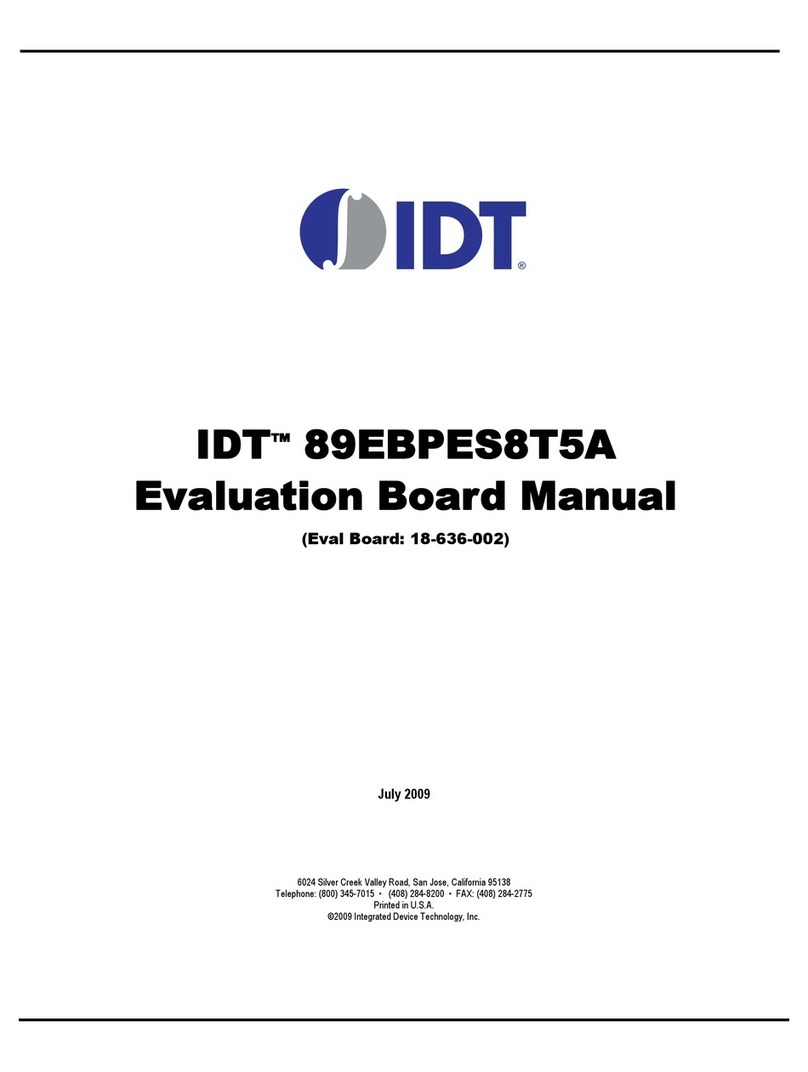
IDT
IDT EB8T5A Eval Board User manual
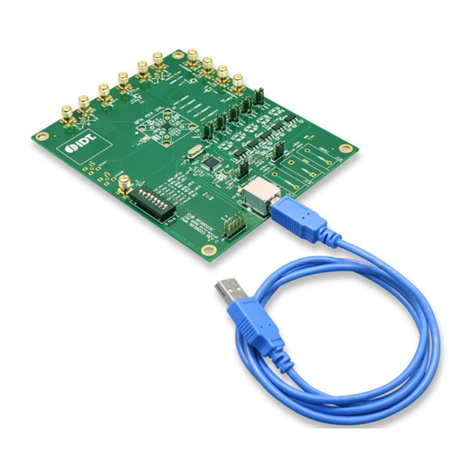
IDT
IDT VersaClock 3S User manual
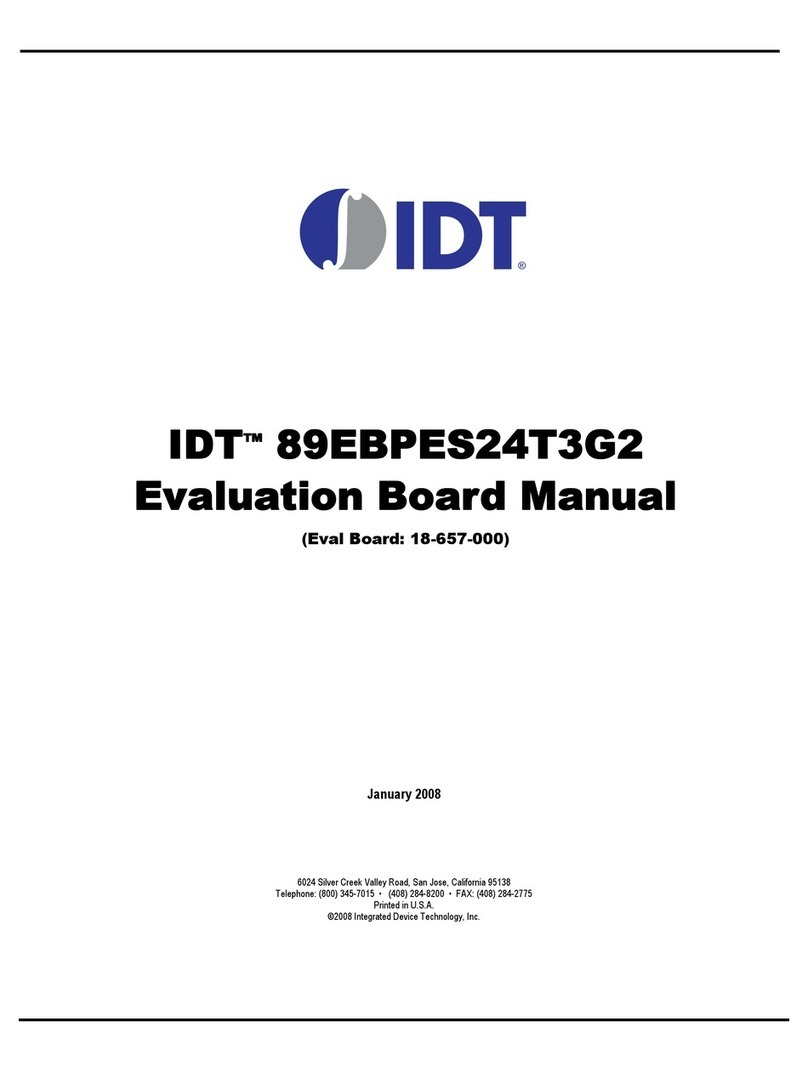
IDT
IDT 89EBPES24T3G2 User manual

IDT
IDT ADC1410S Series User manual
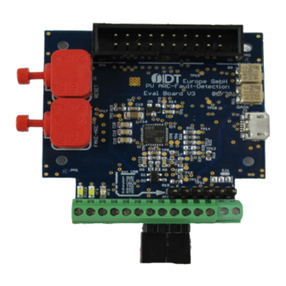
IDT
IDT ZNRG2061 User manual
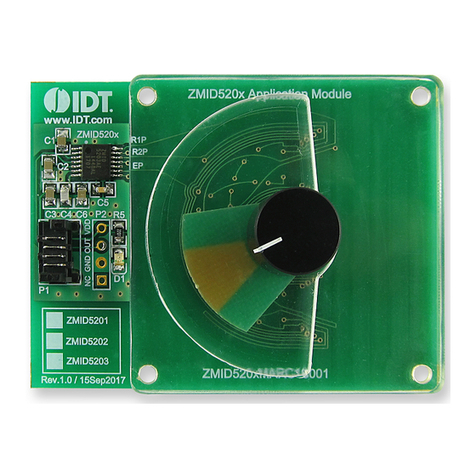
IDT
IDT ZMID520 Series User manual
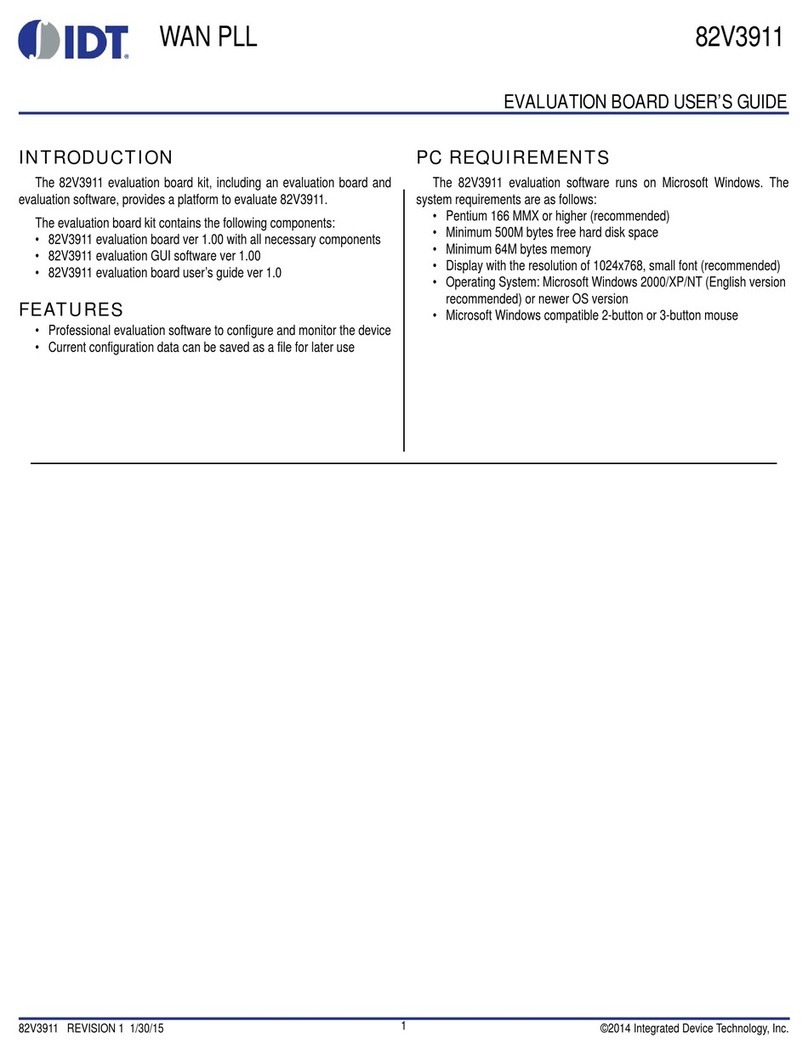
IDT
IDT 82V3911 User manual

IDT
IDT 9ZXL1951D User manual
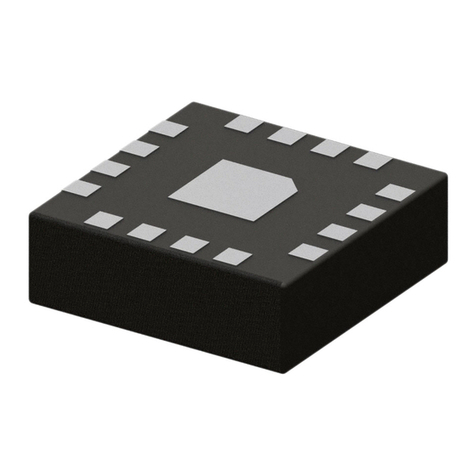
IDT
IDT 9FGV1005 Operating instructions

IDT
IDT 8T49N240 User manual
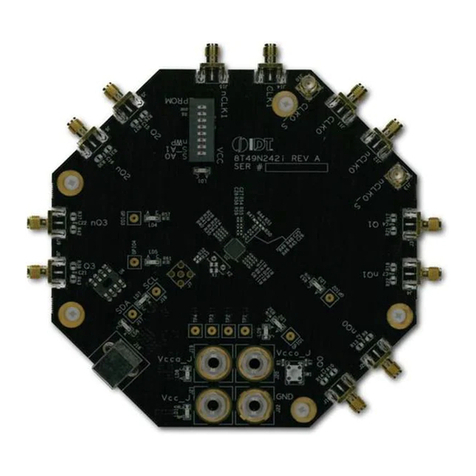
IDT
IDT 8T49N24 Series Installation and operating instructions

IDT
IDT EB-LOGAN-23 User manual

IDT
IDT 82P33731 User manual
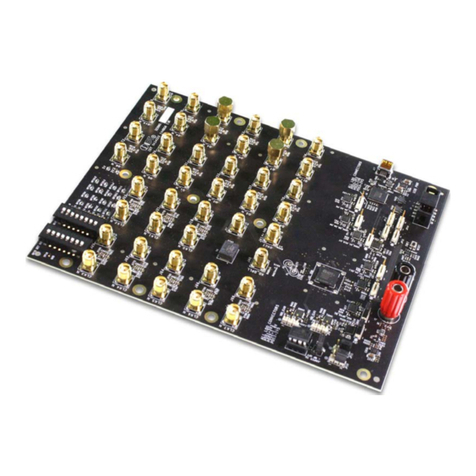
IDT
IDT 8A34 Series User manual
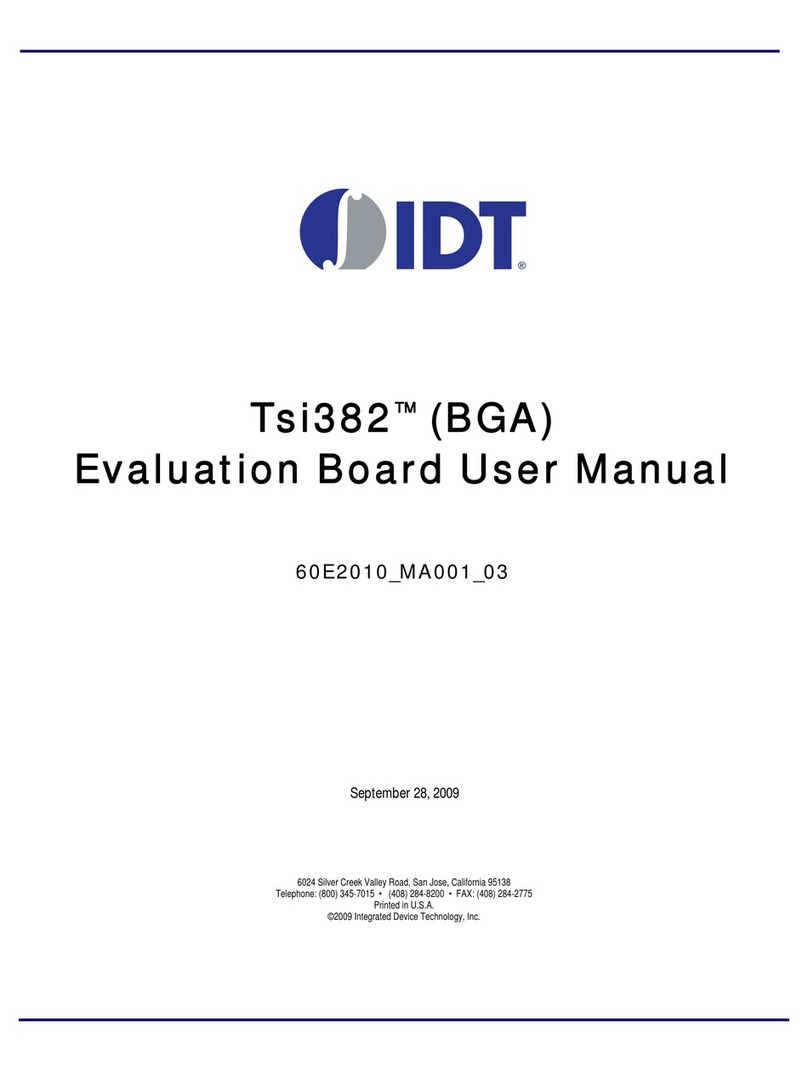
IDT
IDT Tsi382 LQFP User manual
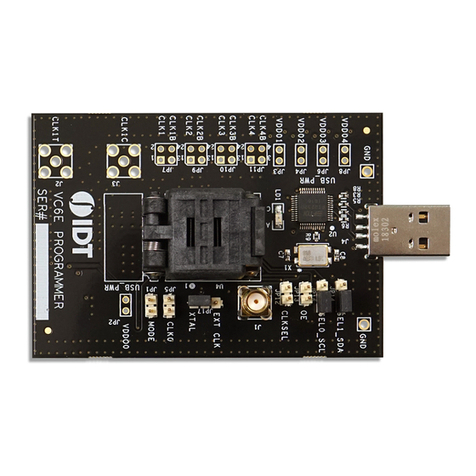
IDT
IDT VersaClock 6E 5P49V6965 User manual
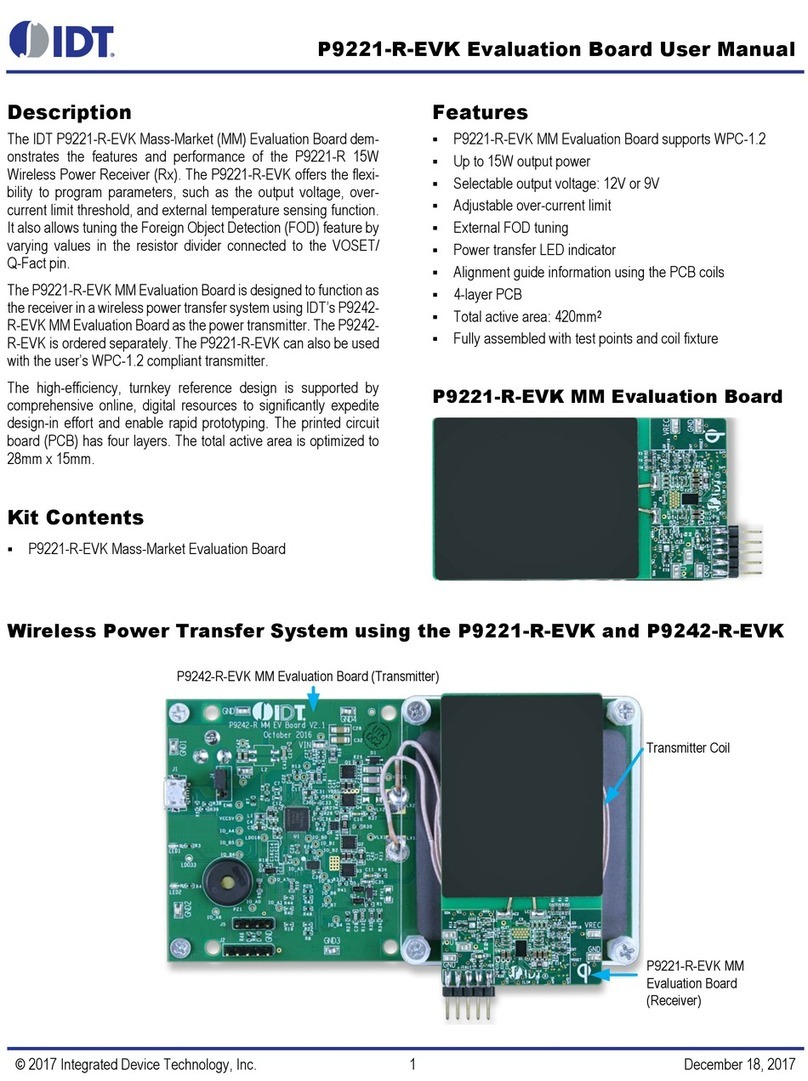
IDT
IDT P9221-R-EVK User manual
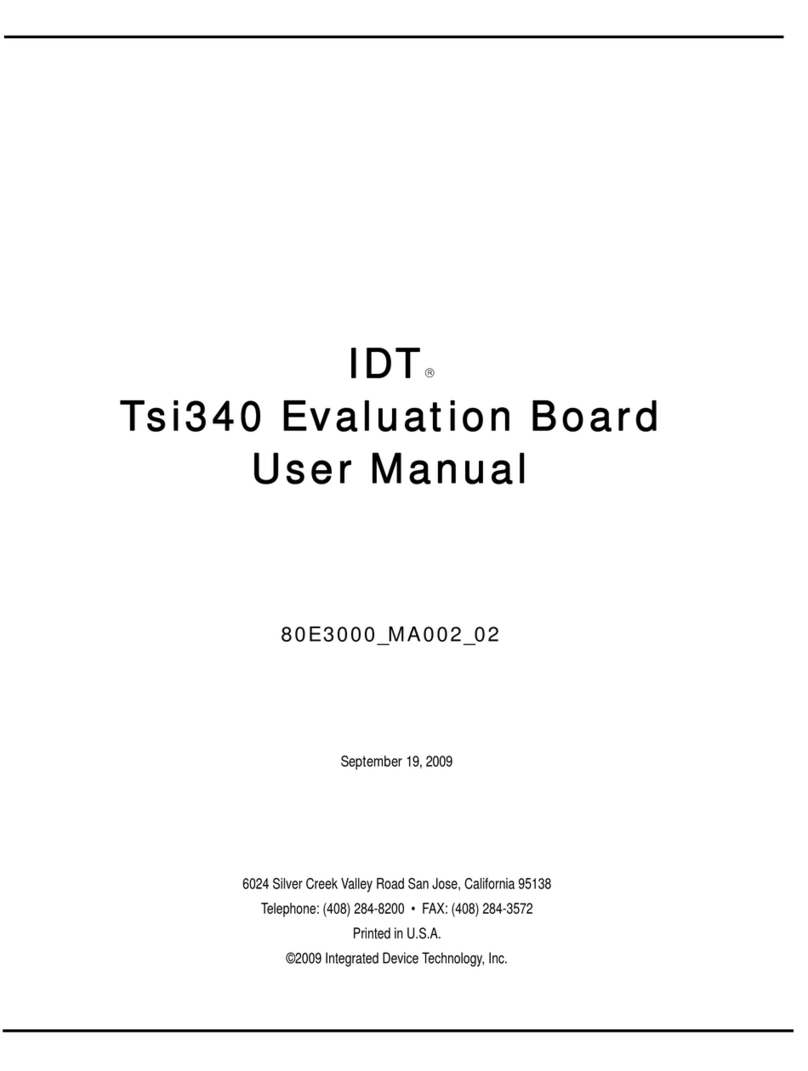
IDT
IDT Tsi340-RDK1 User manual
